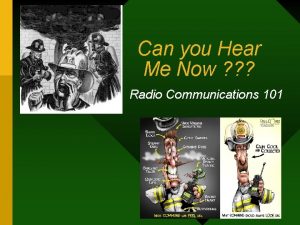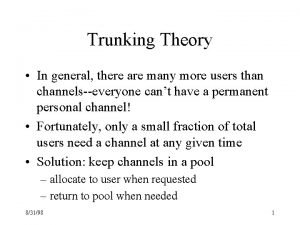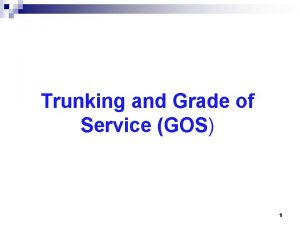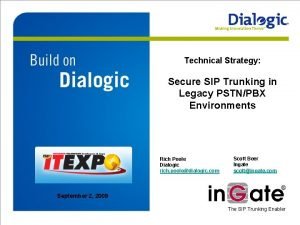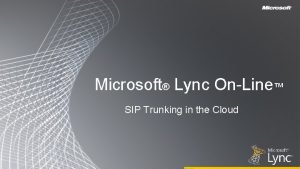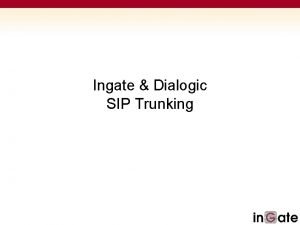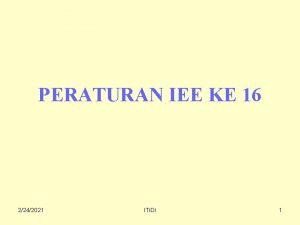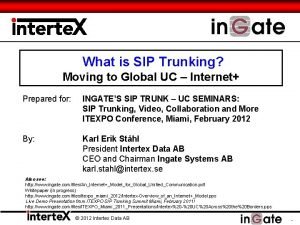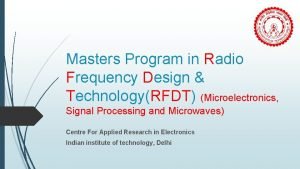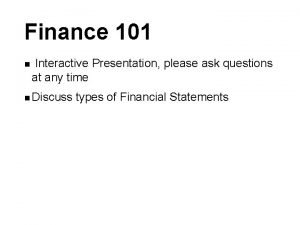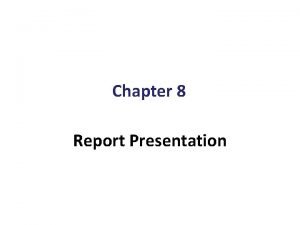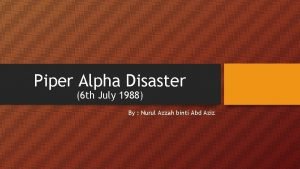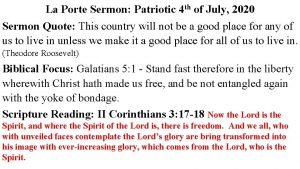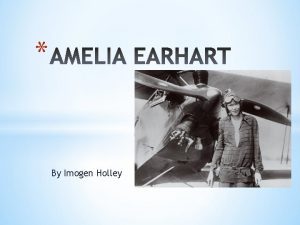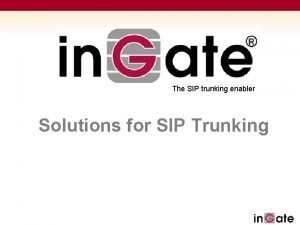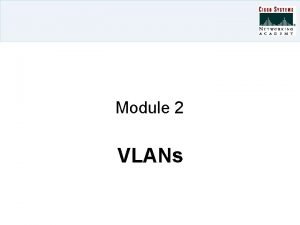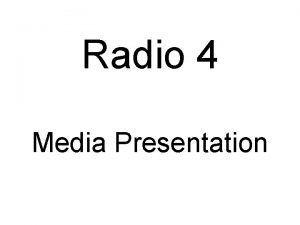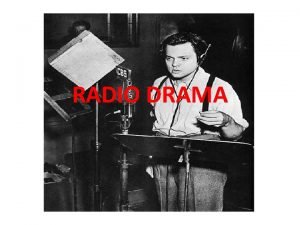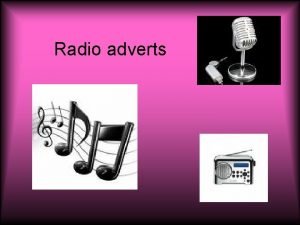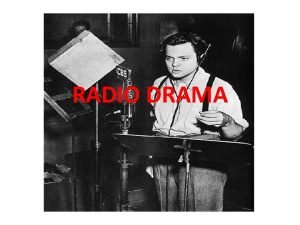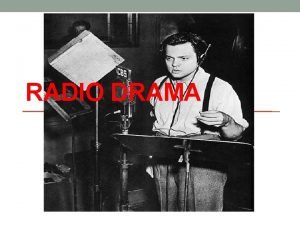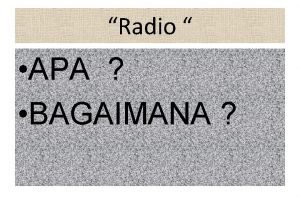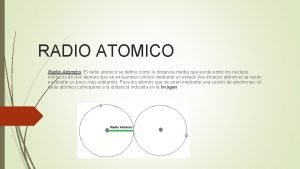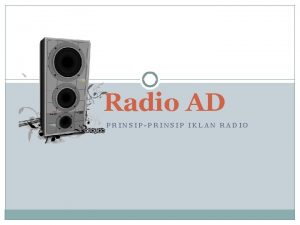Trunking 101 Radio Technology Presentation July 13 2007













































- Slides: 45

Trunking 101 Radio Technology Presentation July 13, 2007 Rey Freeman, Geo. Comm 1

Presentation Agenda Ø Trunking Radio Systems “ 101” • Trunked radio vs. conventional radio systems Simulcast transmitting technology Ø Voting receiver system technology Ø Digital vs. analog modulation technology Ø 2

“Trunking 101” Central Controller 3

What is “Trunking” ? It is NOT a term that “belongs” to Motorola, Ma/Com, or any other manufacturer Ø It is NOT a term exclusively for radio systems Ø It IS a generic term used to describe: Ø “The sharing of a limited number of communications paths (or Trunks) among Many Users” 4

Conventional vs. Trunked Ø Conventional Radio (repeater) system: • Uses a dedicated radio frequency for each radio channel in a system (unless sharing a channel) • A Channel = a Frequency (I. e. , 154. 235 Mhz is County Fire) • Each frequency is assigned to a group of users 5

FD TX RX Fire Channel TX 154. 235 Mhz EMS RX EMS Channel 155. 340 PD TX RX Law Repeater Channel 155. 625 Mhz 6

FD TX RX EMS Fire Channel EMS Channel 155. 340 154. 235 Mhz X ? ? PD 2 PD 1 TX RX Law Repeater Channel 155. 625 Mhz 7

Your Bank Tellers – as “Conventional” Queue by Account PD Admin EMS PW Fire PD FD EMS PD FD 8

Conventional vs. Trunked Ø Conventional Radio (base or repeater) system: • A Channel = a Frequency • If a channel is in use, radio user must wait in “queue” before being able to transmit on the system • …and a new frequency must be obtained each time another “channel” is needed in the radio system • The system is limited by the number of frequencies in the system… 9

Trunked Radio Systems Central Controller 10

Conventional vs. Trunked Ø Trunked Radio (repeater) system: • Uses a group of similar radio frequencies to • • create a “pool” for radio system users to access Systems can be built using VHF, UHF or 800 Mhz A Channel is NOT a Frequency…(generally) A Channel (on your radio) is now a computergenerated code …and are now referred to as “Talk Groups” 11

Conventional vs. Trunked Ø Trunked Radio (repeater) system: • The entire system is managed by a computer, often referred to as the “Central Controller” • All radios in the system also are computercontrolled, and communicate to the central controller via one frequency known as the “Control Channel” 12

Basic Trunking Diagram PD EMS FD TX TX TX RX RX RX CH 1 CH 2 CH 3 CH 4 CH 28 Control Channel Central Controller 1 to 28 Channels 13

Your Bank Tellers – as “Trunked” Queue by First Available Teller Director CH 2 CH 3 CH 4 CH 5 EMS FD PD PD FD IN 14

Conventional vs. Trunked Ø Trunked Radio Benefits: • Greatly improved usage of scarce radio frequencies • Greater overall radio system flexibility, including: üChannel (Talk Group) capabilities üVarious user features, including Emergency Alarm, PTT ID, Channel Regrouping, Call Alert, and Radio Inhibit • Brings radio users together on a common radio system • Consistency in radio coverage 15

So How Does It Work? 16

Control Channel continuously transmits system data to all radios PD FD EMS TX TX TX RX RX RX CH 2 CH 3 CH 4 CH 28 CH 1 Control Channel Central Controller 17

Radio user presses TX button, and radio information is sent via control channel to Central Controller FD TX TX TX RX RX RX CH 2 CH 3 CH 4 CH 28 CH 1 Control Channel Central Controller 18

Central Controller processes inbound request, and sends repeater channel command (CH 3) back to all radios selected on same Talk Group FD FD TX TX TX RX RX RX CH 2 CH 3 CH 4 CH 28 CH 1 Control Channel Central Controller 19

Originating radio user’s radio automatically switches to correct voice channel and begins transmitting; All radios selected on same Talk Group do the same and hear the voice transmission FD FD TX TX TX RX RX RX CH 2 CH 3 CH 4 CH 28 CH 1 Control Channel Central Controller 20

When transmission is completed, all units revert back to Control Channel FD FD TX TX TX RX RX RX CH 2 CH 3 CH 4 CH 28 CH 1 Control Channel Central Controller 21

Radio System Fleetmapping: Radio “channels” are now called “Talk Groups” (Law Enforcement shown here) 22

Fire & EMS Talk Groups 23

Questions…so far? 24

Simulcast Transmitting Systems Ø Simulcast Transmitting is defined as: • A radio system where the same radio frequencies are Simultaneously Broadcast from all tower sites within the radio system • This allows same radio frequencies to be used throughout the entire coverage area 25

Simulcast Transmitting Systems Ø Simulcast Benefits: • Seamless communications throughout the radio system’s coverage area • Improved radio frequency utilization • Improved coverage in areas with difficult terrain • Improved in-building coverage (signals in overlap zones are “additive”) 26

Simulcast Transmitting Systems Ø Simulcast “cons”: • Not inexpensive technology • Tower site spacing is critical (especially when using NPSPAC frequencies) • Signal “timing” is critical between all sites • Tower site interconnection (microwave, T 1, etc. ) is also critical and can be expensive 27

Simulcast Transmitting Systems Site 1 Site 2 f 1 f 2 f 3 f 4 f 5 Site 3 28

f 1 f 2 f 3 f 4 f 5 Kandiyohi Co MN – with Simulcast 29

30

“Simulcast” fills in where single site can’t 31

Simulcast Issues • Amplitude and frequency of transmitted signals must be very accurately timed to ensure good signal quality 32

Simulcast Issues • Slightly out of phase “Ghosting” on a T. V. set • Out-of-phase signals can cause destructive cancellation • Fully in-phase signals produce constructive composite signal 33

Discussion and questions regarding Simulcast transmission techniques and issues? 34

Multicast Transmitting Systems Ø Multicast Transmitting is defined as: • A radio system where different radio frequencies are used at each tower site within the radio system Ø Multicast Benefits: • Reduced system complexity • Minimized site spacing issues • Lower system overall system cost 35

Multicast Transmitting Systems Ø Multicast “cons”: • Very high frequency usage (each site needs its own set of frequencies) • No Simulcast coverage benefits (overlap, voting) • Units “roam” between sites 36

f 1 f 2 f 3 f 4 f 5 f 6 f 7 f 8 f 9 f 10 Kandiyohi Co MN – with Multicast 37

ARMER System In the ARMER system, each tower site is connected back to Zone Controller via microwave or other network link Ø Typical ARMER tower site is Multicast Ø Typical Local Ehancement system is Simulcast Ø 38

Zone Controller 39

Radio System Modulation Technologies • Analog vs. Digital: Ø Most existing Public Safety radio systems are analog Ø New 800 Mhz system are digital Ø So what’s the difference? Ø Is digital better, and why? 40

Modulation Techniques Analog transmission Digital transmission Information is sent by changing the frequency, amplitude or phase of the radio signal Information is converted to true data bits, and applied directly to the radio transmitter using FDMA, (or TDMA or CDMA) 41

Modulation Techniques • Digital Benefits: ØClearer audio throughout system coverage area ØImproved radio frequency efficiency ØImproved system coverage ØImbedded signaling options ØEncryption with no range loss 42

Voting Receiver Technology Ø In a multi-tower site radio system, a mobile or portable radio transmitting within the system’s range has a good probability of being heard by more than one tower site Ø In a Voting receiver system, the same-frequency receivers of the trunked repeater stations are connected together back to a main site… Ø …where – in a digital system – all received signals from one “channel” are combined (added) together and used to create a the final received product… Ø …which may be stronger than the original signal! 43

Voting Receiver Systems Site 2 Site 3 Site 1 f 2 f 3 f 4 f 5 f 1 f 2 f 3 f 4 f 5 Received audio to System 44

Discussion & Questions 45
 Radio trunking 101
Radio trunking 101 Conventional radio system
Conventional radio system Sources nso frenchhowell neill mit technology...
Sources nso frenchhowell neill mit technology... Trunking theory
Trunking theory Trunking and grade of service
Trunking and grade of service Sip trunking poole
Sip trunking poole Baile trunking
Baile trunking Lync sip trunk provider
Lync sip trunk provider Yt6 trunking
Yt6 trunking Sip trunking training
Sip trunking training Peralatan pengasingan dan pensuisan
Peralatan pengasingan dan pensuisan Trunking efficiency in wireless communication
Trunking efficiency in wireless communication Vtp protocol
Vtp protocol Global crossing sip trunk
Global crossing sip trunk Virtual lan (vlan)
Virtual lan (vlan) Brocade isl trunking license
Brocade isl trunking license Radio frequency design and technology
Radio frequency design and technology Procurement 101 presentation
Procurement 101 presentation Leadership 101 presentation
Leadership 101 presentation Fundraising 101 presentation
Fundraising 101 presentation Contracting 101 presentation
Contracting 101 presentation Seo 101 presentation
Seo 101 presentation Finance 101 presentation
Finance 101 presentation Aasb 8
Aasb 8 Harris burdick archie smith boy wonder
Harris burdick archie smith boy wonder Harris burdick captain tory
Harris burdick captain tory July 1-4 1863
July 1-4 1863 Tender mean
Tender mean Antwrp
Antwrp 2001 july 15
2001 july 15 2003 july 17
2003 july 17 July 30 2009 nasa
July 30 2009 nasa What is the significance of july 4 1776 brainpop
What is the significance of july 4 1776 brainpop Sylvia plath poppies in july
Sylvia plath poppies in july Miss cuba receives an invitation
Miss cuba receives an invitation Poppies in july poem
Poppies in july poem July 10 1856
July 10 1856 Ctdssmap payment schedule july 2021
Ctdssmap payment schedule july 2021 July 1969
July 1969 Slidetodoc.com
Slidetodoc.com Monday 13th july
Monday 13th july On july 18 2001 a train carrying hazardous chemicals
On july 18 2001 a train carrying hazardous chemicals July 4 sermon
July 4 sermon June too soon july stand by
June too soon july stand by July 2 1937 amelia earhart
July 2 1937 amelia earhart June 22 to july 22
June 22 to july 22
